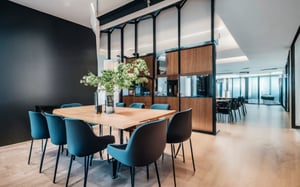A lone guitar strums somewhere in the distance, echoing through the modern office with its sleek design and glass walls offering a stunning city view.
A tumbleweed rather inexplicably rolls across the floor.
No, you haven’t accidentally stepped onto the set of The Good, The Bad, and The Ugly—it’s just another day wandering the empty conference rooms in your building and wondering what they say about the health of your corporate operations.
Empty conference rooms crop up for all kinds of reasons. It’s time to stop all that aimless wandering and wondering, show down against some of the most common reasons your organization suffers from empty conference rooms, and take aim at solving each one once and for all.
3 reasons you suffer from empty conference room syndrome—and how to solve each
Imagine your office meeting spaces resembling a desolate Wild West town at high noon, with empty conference rooms echoing silence. It's a scene many workplaces experience, and it's often referred to as the "empty meeting room syndrome."
This phenomenon occurs when conference rooms, which should be bustling hubs of collaboration and productivity, sit vacant for extended periods. Understanding the root causes of this issue is crucial to addressing it effectively.
Often, it's a sign that your available meeting spaces aren't aligning with your team's actual needs. It could be due to clunky booking systems, lack of awareness about available rooms, or spaces that don't fit how people work today. With the rise of remote work and virtual meetings, rethinking how you use your physical meeting areas is essential. By getting to the root of the problem, you can turn those empty rooms into hubs of creativity and teamwork.
In the following sections, we will delve into the reasons behind this syndrome and explore actionable strategies to breathe life back into these neglected spaces.
Reason 1: Ghost meetings make it seem like empty conference rooms are utilized more than they are
If you often hear complaints from employees that every time they go to book a meeting space, it seems like there aren’t enough options—you’re not alone.
This is a common refrain at businesses of all sizes. The problem is, it hardly ever reflects the reality of the situation.
This is a phenomenon known as “Perceived Utilization” and it happens when ghost meetings make it seem like all your usable meeting space is taken up even though it’s actually sitting around empty.
Ghost meetings aren’t caused by employees with malicious intent. Rather, they typically result from outdated—or totally nonexistent—tools for meeting planning and management.
Ghost meetings that skew your organization’s understanding of space utilization aren’t just frustrating and draining on productivity, the high expense of wasted real estate can hit quite hard. Many a company has spent a hefty sum on renovations or new space just to establish more of what end up being rarely-used, empty meeting rooms.
One example is the consulting firm Ernst & Young (EY). They used data collected from their meeting room management tools to see how their meeting areas were actually being used. What they found was that they really didn’t need all three floors of their Manhattan office. These insights ended up saving the company $85 million in Manhattan—and $500 million across their offices around the world.
Solution: Banish Ghost Meetings and Understand Utilization with Meeting Management Tools
Gartner estimates that employees waste nearly 30 hours every year just searching for an appropriate meeting space. And as we’ve just learned, they’re unlikely to have trouble because there’s nowhere to meet. Rather, they’re spinning their wheels because you just don’t have a good meeting management system in place to help them find and secure fitting spaces—and help you gather analytics on how those spaces are being utilized so you can make them more useful and less empty.
Investing in modern meeting management tools can be a game-changer. These tools simplify the booking process and provide valuable insights into space utilization. You can track which rooms are frequently used and when they are in high demand and optimize their availability accordingly. Plus, with user-friendly interfaces and mobile apps, your employees can effortlessly reserve meeting spaces that suit their needs, eliminating the frustration of endless searches—banishing ghost meetings for good!
Reason 2: Meetings Are Happening More Often—And Less How You Expect Them To
The nature of work is changing. Individual-led tasks are giving way to team-based, collaborative work. Two-thirds of organizations estimate that their employees collaborate between 60 and 80 percent of the time! That means employees are looking for meeting spaces more often, but they’re looking for more intimate and casual spaces than they used to.
In fact, over 35 percent of meetings only have two participants, yet fewer than 5 percent of meeting rooms are designed for just two people.
The meeting spaces that exist today simply aren’t designed in a way that makes them comfortable for small, collaborative sessions. This leads to employees either drowning in overly-large and overly-formal conference rooms or ghosting scheduled meetings in favor of alternative solutions—which just keeps plummeting you deeper and deeper into the harmful consequences of ghost meetings.
Solution: Reinvent Empty Conference Rooms to Better Meet Modern Standards
Business users desire ad-hoc meeting spaces that are as agile as the new speed of doing business. Boost morale and save on money and space by giving workers what they’re asking for—collaboration-friendly meeting areas!
If you don’t have the budget to completely renovate, we get that! Try room dividers to divide large, empty conference rooms into more intimate and useful meeting areas. Instead of investing in new spaces, have your bigger meeting areas pull double duty as game rooms or exercise zones when they’re not in use.
Once you’ve narrowed down the spaces, you could invest in comfy, lightweight furniture that can be moved around—or even removed—so small groups can customize their collaboration sessions.
This last tip applies to meeting spaces large and small—make sure to have modern, user-friendly meeting equipment that works! How are self-driving cars a thing when I can’t even get the conference room Wi-Fi and HDMI to work?
Reason 3: Employees Clog Up Large Conference Rooms Because Smaller Meeting Spaces are Under-equipped
As we just explored, employees are meeting more frequently yet in smaller groups than ever before. Yet, even when more intimate spaces are available for collaboration, small groups may still gravitate toward large, empty meeting rooms. Why? to gain access to the technology they need.
Let's dive a bit deeper into this tech puzzle. Imagine your employees armed with laptops, tablets, and smartphones, all geared up for a productive meeting. They want to brainstorm, share ideas, and collaborate seamlessly. Now, they spot a large, vacant conference room – it's enticing, with its spaciousness and high-tech gadgets. But here's the catch: it's often overkill for their needs. This space, designed for more significant gatherings, may have a giant screen, elaborate audio-visual equipment, and all the bells and whistles. But it's like using a sledgehammer to crack a nut for your small group of colleagues.
What happens? They may struggle with the technology, waste time fumbling over intricate setups, or simply avoid the room because it's too intimidating. As a result, these underutilized large meeting rooms become a bottleneck in your office space, while smaller, cozier spots remain unappreciated.
Take, for example, something as rudimentary as video conferencing software. Worldwide, less than 2 percent of the 50 million huddle rooms (or whatever a business chooses to call their small, creative spaces) are smart enough to handle video conferencing. This starkly contrasts nearly 90 percent of employees who use video in their day-to-day lives and the 60 percent who expect to be able to use it just as frequently at work. All told, less than 30 percent of workers can use video in the workplace.
Video software is just one example of how poorly-equipped meeting areas can clog up large meeting rooms that could be better utilized.
Solution: Identify and Deploy the Meeting Equipment Workers Want
The solution to this reason for empty meeting rooms is pretty straightforward: Identify and then deploy the appropriate meeting equipment in the appropriate meeting spaces.
Invest in meeting management software that provides utilization metrics on how spaces are being used, which spaces are the most popular, what kind of equipment drives usage, and other statistics that will help you figure out what accessories will help maximize lesser-used spaces—whether that’s the aforementioned video conference software, smart boards or in-room meeting displays to improve the attendee experience.
Implementing meeting management technology can be a big project, but it doesn’t have to be a total pain in the IT department. Additionally, consider involving your employees in the process. Seek feedback on the types of equipment and features they believe would enhance their meeting experiences.
By making technology deployment a collaborative effort and tailoring it to your employees' needs, you can ensure a smoother transition and greater success in transforming your underutilized spaces into vibrant hubs of collaboration and productivity.
Need more help towards better conference room utilization?
If you’re still not sure exactly which meeting management tool is a good fit for your organization, we’ve got a guide for that, too. If you’re using Microsoft 365, Outlook, Microsoft Exchange, Microsoft Teams, or Microsoft Bookings; AskCody can help you take control of every dimension of the meeting experience to finally achieve everything you have always wanted to accomplish with your Microsoft suite.




